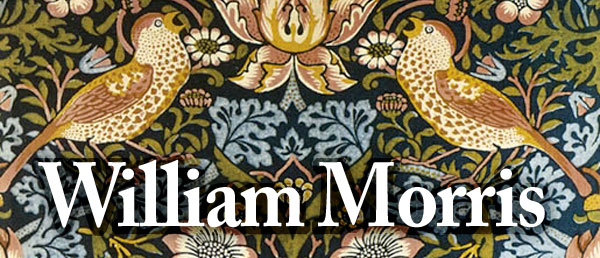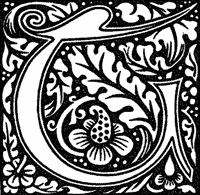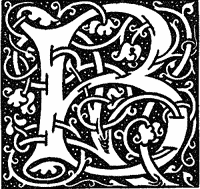William Morris is probably the most recognized individual in the entire Art Nouveau movement — but what most people don’t know is that he also contributed his style and art vision to type and typography as well.

 HE ART NOUVEAU MOVEMENT would never have been the same without William Morris. A true Renaissance man, William Morris mastered every art and craft to which he set his hand, revelling in designs, patterns, colours and textures, and placing his stamp on sumptuous books, rugs, embroidery, wallpaper, stained glass, tapestries, curtains and furniture.
HE ART NOUVEAU MOVEMENT would never have been the same without William Morris. A true Renaissance man, William Morris mastered every art and craft to which he set his hand, revelling in designs, patterns, colours and textures, and placing his stamp on sumptuous books, rugs, embroidery, wallpaper, stained glass, tapestries, curtains and furniture.
ART NOUVEAU {ahr noo-voh’}, a French term meaning new art, refers to a style of architecture, of commercial and decorative art, and, to some extent, a style of painting and sculpture that was popular about 1900. Although the style was then thought of as modern and was given the title “new art,” it was adapted from older styles and art forms. Much was derived from the Gothic and rococo and from the arts of Java and Japan.

The Art Nouveau movement was also inspired by Celtic manuscripts and the drawings of William Blake. Persian pottery and ancient Roman glass also served as models for some Art Nouveau craftsmen.*
WILLIAM MORRIS was the founder of the Art Nouveau Arts and Crafts Movement in England. Employed by the renaissance of decorative arts, Morris studied medieval architecture at Oxford, but under the influence of Edward Burne-Jones and Dante Gabriele Rossetti, leaders of the Pre-Raphaelite movement, he turned toward painting and writing.

In 1861, Morris, Burne-Jones and Rossetti founded a guild of fine arts craftsmen and began to produce furniture, tapestry, stained glass, tiles, fabrics and the most famous wallpaper designs. They also explored the total vision of art and craft for Red House, in South London countryside, where every detail of architecture, furnishing and decorative elements were completed as a whole artwork.*

Morris’ art was emotional and mythical. His love of country-garden nature and medieval ideals of chivalry as well as the romantic attachment to forests, gardens, flowers and birds has inspired artists for a century. But Morris also designed illuminated typography!
 Along with the artistic endeavours, Morris was also a writer and poet. His manuscripts would be decorated with lavish illuminations, borders and cartouches. He became so well known for the art that printers and publishers began to seek him out to illustrate. Popular publications began to see Morris works in both illustration and lettering. Again, the style’s patterns and motifs were taken primarily from nature and were often carried out with unrestrained exuberance of form, color, and especially line. The characteristic line, a flowing curvilinear, was to give Art Nouveau the descriptive nicknames “noodle,” “whiplash,” “tapeworm,” and “cigarette-smoke style.”*
Along with the artistic endeavours, Morris was also a writer and poet. His manuscripts would be decorated with lavish illuminations, borders and cartouches. He became so well known for the art that printers and publishers began to seek him out to illustrate. Popular publications began to see Morris works in both illustration and lettering. Again, the style’s patterns and motifs were taken primarily from nature and were often carried out with unrestrained exuberance of form, color, and especially line. The characteristic line, a flowing curvilinear, was to give Art Nouveau the descriptive nicknames “noodle,” “whiplash,” “tapeworm,” and “cigarette-smoke style.”*
Anyone interested in learning more, or in actually using the works of Morris should take a look at William Morris Designs (CD-ROM and Book) This is a collection of Morris’s work, contained in a print book and then as clip art on CD ROM — which also happens to include some spectacular illuminated lettering and scroll mortised borders. This copyright-free collection offers countless idea starters and actual art you can use.
We offer here, a look at just some of the plates and art files included in the collection: William Morris Designs

One can never have enough visual reference material. This book among many of the others in the Dover Pictorial Archives not only offer sound art for graphic design solutions, but also provide a lot of visuals for perusing. I’ve owned a number of the books for years, and they always suggest the spark of an idea for projects — whether a starting point on my own art, and interpretive exploration or used literally right out of the book.
Thanks for reading
Don’t forget … we encourage you to share your discoveries about favorite or famous graphic designers and illustrators with other readers. Just contact me here, or just give me a tweet at Twitter/DTG_Magazine
Further Reading:
- Art Nouveau reference: discoverfrance.net
-
More about William Morris : www.senses-artnouveau.com
-
More about the “Styles” of the Art Nouveau movementartchive.com
-
More historic information about the Art Nouveau movement
- William Morris in Applique: Six Stunning Projects and Over Forty Individual Designs by Michele Hill – Capture the glory of William Morris’ designs in 6 exquisite appliqu, projects: quilts, cushions, and wallhangings. Mix and match more than 50 appliqu, motifs.
- William Morris: Patterns & Designs (International Design Library) by Phoebe A. Erb – William Morris’s visions, combining intricacy and simplicity; alternatingly dramatic and demure, dark and light, curved and angular, in a virtual dance of superb interwoven shapes.
- William Morris Full-Color Patterns and Designs by William Morris – beautiful designs by one of Victorian era’s most influential designers. Modestly priced, copyright-free collection of richly detailed patterns, faithfully reproduced from rare 1890s publication. Superb designs for wallpapers, chintzes, velveteens, tapestries, tiles, carpets, more.
- Designs of William Morris by Editors of Phaidon Press — William Morris designed some of the finest wallpapers and fabrics of the 19th century, many of which are still in use today. This collection of beautiful drawings and designs evokes Morris’ charm and genius, revealing how his ideas on the nature of art and its importance in everyday life have had a far-reaching impact on art and design. 104 illustrations, 99 in color. (Phaidon Miniature Editions)
- William Morris Stained Glass Coloring Book – Just for fun, and inspiration, see these sixteen handsome renderings based on projects by one of Victorian England’s foremost leaders of the Arts and Crafts movement. Includes adaptations of wallpaper and textile designs as well as scenes of Adam Naming the Beasts, Sleeping Apostles, Angel and Woman, and many more. Add color and place translucent illustrations near a source of bright light for brilliant stained glass effects. (Dover Pictorial Archives)
